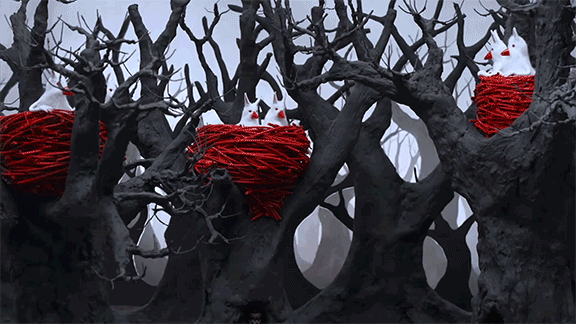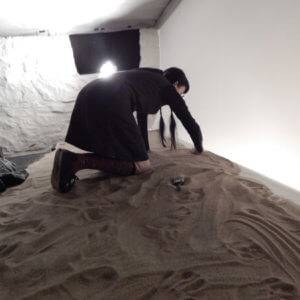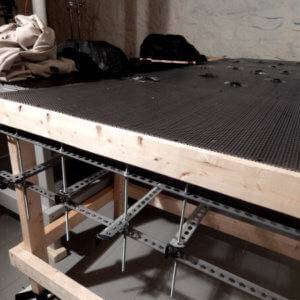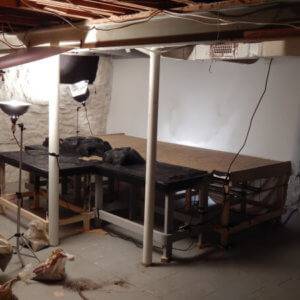Christiane Cegavske Interview: The Alchemy of Animation
Christiane Cegavske is a fabricator of self-spun tales, the sole architect of a handmade fantasy world. The award winning director and stop-motion animator is perhaps best known for her feature-length film, Blood Tea and Red String (2006). Her cult status, is due in part to the time it took to complete it—a small matter of 13 years. Certainly, to hear of an artist who operates alone and outside of a conventional timeframe is liberating. Cegavske’s aims seem to be truly independent. Her unparalleled devotion has now sustained her onto the creation of her next film: Seed in the Sand. And it’s already well underway with production.
Once again, we’ll visit the surreal landscapes inhabited by Cegavske’s puppet creations. Her artistic lens is perhaps unique in its ability to magnify the lives of small creatures, playing out the extreme emotions of animals which live in sheltered dwellings. In Blood Tea, we met with the oak-dwellers, who live beneath the hollowed-out trunk of an oak tree. These animals have beaks yet exert a mammalian tenderness. Their peaceful existence is thrown into disarray when the object of their affection (a doll) is stolen and they must embark on a quest to reclaim it.
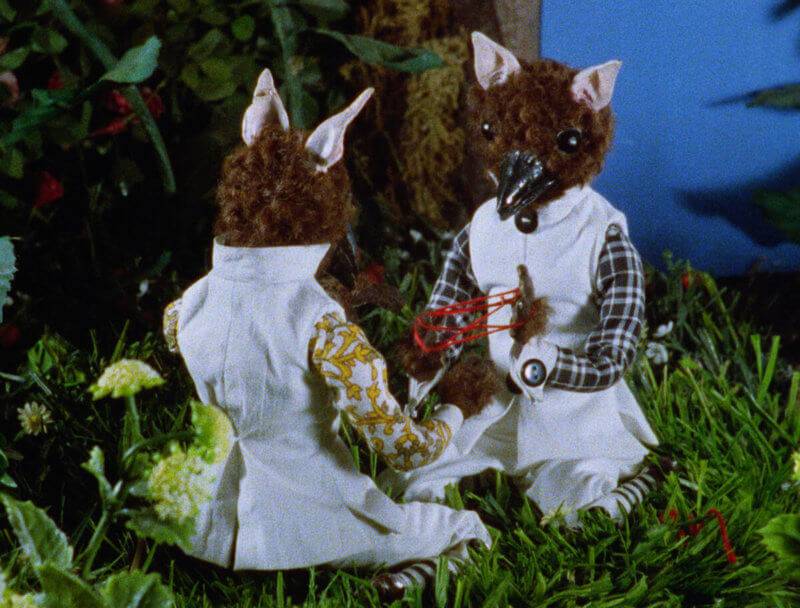
Blood Tea and Red String (Dir. Christiane Cegavske) [Source]
Cegavske’s decision to abstain from dialogue and speech in her work, permits the opening up of interpretation. Her message needn’t be translated to enter film festivals, for there is something buried (in the sand) that will take root intuitively. Her films are instead formed from a language of personal mythos, as are her paintings and poetry. Cegavske distils inspiration into an exclusive colour palette and a creative process, such as hers, is not unlike alchemy. Red, Black and White: these are the essences which formulate her miniature tales. We interviewed Christiane Cegavske to discuss the progress of her next feature and to get an insight into her practice.
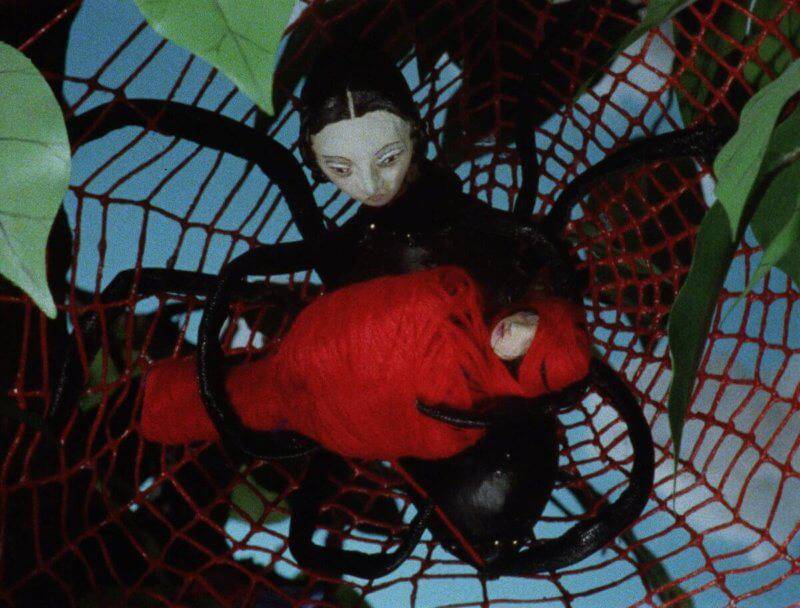
Blood Tea and Red String (Dir. Christiane Cegavske) [Source]
I think my audiences find the characters compelling. The tactile intimacy in the way the characters are filmed where the textures of the fur and clothing emphasise their materiality and dimensionality, making them seem entirely real even though they are impossible creatures. Despite the absence of dialogue, their gestures and communications are readable and their emotional states relatable so they seem like real, living beings. The overall aesthetic, the colour palette, the strangeness of the story and the immersive environment, at once familiar and foreign, also seem to be a draw.
Your creative process has changed quite a bit since the completion of Blood Tea and Red String. During the production of Seed in the Sand, you’ve employed a few interns along the way. Fans of your work can now also follow the film’s development online as you post pictures and videos. As an artist, how do you feel your work is affected by this kind of exposure? Have you enjoyed opening up the artistic process to other people?
I like to show work in progress. Feedback and appreciation help me to persevere over this long-term project. I think my creative process has remained much the same, I now have a greater platform to share it. I am more mindful of documenting progress in ways I didn’t or couldn’t while working on Blood Tea and Red String. I am much more aware of cinematic editing techniques, meaningful juxtapositions, and intentional symbolism now, though, I still allow much of the narrative to flow along in dream-logic fashion just as it comes to me.
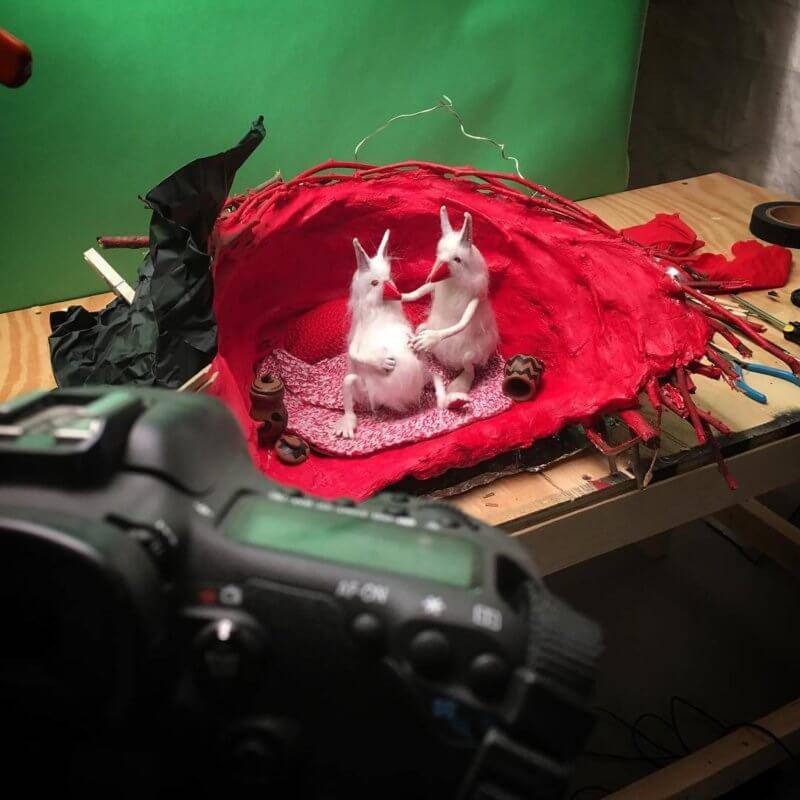
Production Still from Seed in the Sand [Source]
I haven’t set out to give a specific lesson, but you can see the consequences of the actions of the characters, both positive and negative. That can be instructive. In Blood Tea and Red String, everyone loses that which they were initially striving for. The protagonists and one of the antagonists evolve in their quest to reclaim the doll. As soon as the Oak Dwellers see the bird girl, fragile and alive, their purpose becomes rescue. When the one white mouse sees the bird girl born out of the doll, his epiphany brings transformation and a new goal. Two of the mice never shift their focus and end up with the object of their desire, but it is broken. I avoid creating characters who embody absolute evil. The antagonist’s selfish deeds can be considered bad from the protagonist view, but could be interpreted as justifiable by them. Both sides engage in myopic and self-serving behaviour as well as selfless acts.
As any stop-motion animator will know, the filmmaking process requires ceaseless dedication, hard work and attention to detail. This is perhaps especially true for you, as you work primarily alone upon all facets of filmmaking. The final product must therefore be a huge personal accomplishment. How do you manage to remain motivated when dates of completion are set so far into the future?
I break up the work into manageable pieces in a long-term production schedule with solid goals dispersed along the way. Finish a puppet, build a set, complete a scene; each is a small triumph. Opportunities to show my work in progress are also very rewarding and motivational. When my audience gives me a positive response and expresses a desire to see more, it spurs me on.
- Wave Generator
You have already released some astonishing clips of sand in tidal motion. What was your experience of animating with sand prior to the decision to include it in your film? It must have been extraordinarily challenging to build your wave generator!
I had very little experience in sand animation before this scene. The design for the wave generator came to me in a flash of inspiration and it was very exciting to build it. I had two interns working with me at the time who were extremely helpful. The generator design was meant to create the waves in the open sand sea, but the scene that I have used it for so far was at the shore where waves had to break on the rocks. Though it did help somewhat with the rhythm of the waves, a great deal of hand animation had to be done.
Without giving too much away, how will Seed in the Sand extend upon the imagined world of your first feature? Is it true you have envisioned a trilogy of films?
I am backing off from considering these as being a trilogy, but there is a flow from one to the next in the live action portions. There is an element that transforms from beginning to end that is passed to the next film. In Blood Tea and Red String an egg is sent into the animated world and returns to the live action world as a large golden gem. It is that gem that is sent into the animated world of Seed in the Sand by the live action masked woman and it will be transmuted, returning to the live action world as something new at the end that will be useful in the beginning of the third film.
The surreal work of Jan Svankmajer, in particular his film Alice, opened up the world of animation to you. Are there any animators or artists you have recently discovered?
Some artists besides the ever fascinating Jan Svankmajer and Leonora Carrington that interest me lately are Chiharu Shiota, Kirsten Lepore, Allison Schulnik, Miwa Matreyek, Saya Woolfalk, Hans Belmer, Yayoi Kusama, Kiki Smith; and writer Caitlin Kiernan.
In the language of your films, there are certain images and symbols you return to, as if revisiting a dream or a nightmare. One such image is the egg. In the past, you’ve listed your influences to include Leonora Carrington, the surrealist painter, and the egg is often a feature of her paintings. In Carrington’s memoir she wrote ‘The egg is the macrocosm and the microcosm, the dividing line between Great and Small, which makes it impossible to see everything at once’. I wonder how you relate to the egg in your own work and whether it could be emblematic of your creative process as a whole, from conception to the creation of your imaginative worlds.
I see the egg as a protective container in which to grow, change, enter the world or pass from one stage into the next. The surface is smooth and featureless, the interior is a mystery. I hadn’t thought of an egg being emblematic to my process, but one could interpret the intentional isolation needed while working on this film as being inside of the shell of the egg. Much happens, but little is seen by those on the outside. The yolk could be the accumulation of inspiration and research that I feed on to fuel my creation. I could go on free associating metaphor, but I think I’ll stop here for now.
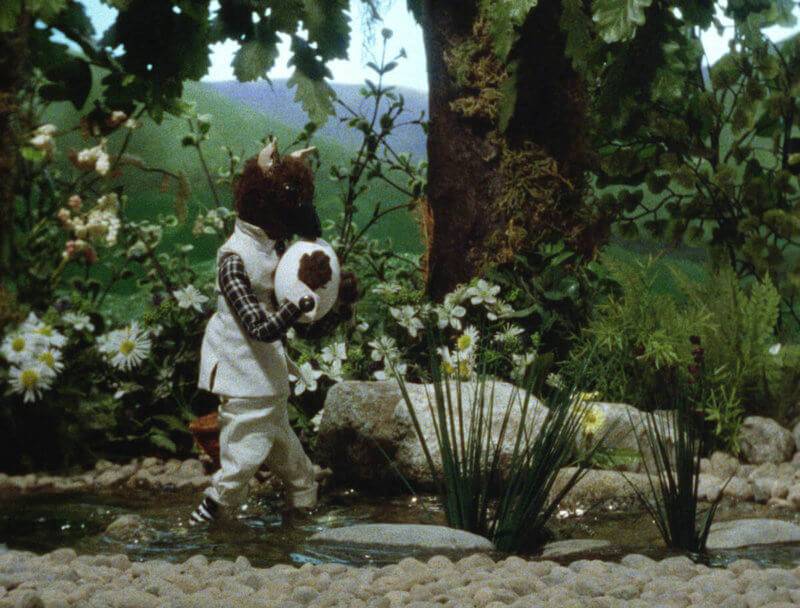
Blood Tea and Red String (Dir. Christiane Cegavske) [Source]
I’ll never say never, but at this point I don’t see myself working in virtual reality on my narrative projects as I want to curate every frame to tell the story in effective cinematic language. Though I have gone from film to digital, the end result remains a collection of still images projected in sequence to imitate life.
Lastly, do you have any advice for an independent animator trying to find their way?
Follow your passion and don’t give up. Hone your skills every day. Find a way to make progress on your project whether you secure funding or not. Don’t wait around for a big grant or investor to start working. It is your passion and perseverance that will serve you best and attract people to help you. There is always something you can do to keep your project moving forward, even if it doesn’t feel like it is enough at the time. Oh, and network, network, network! Make a strong effort to connect with other animators as peers and mentors. It is a small but strong community. Perhaps I have just been lucky, but I have found that animators tend to be really supportive of each other. Volunteer to help with a friend’s project if you can. Invite skilled friends to help you. Seek freelance animation jobs. You learn a lot when working with others. Cultivate connections with people willing to give you truly insightful critique. Be willing to hear the negative along with the positive. And finally, the more you animate, the better you become. Work, work, work.
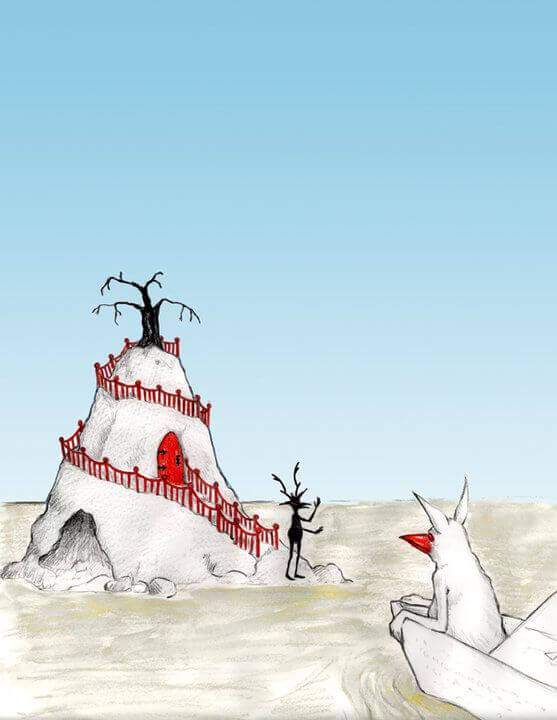
Production Artwork for Seed in the Sand [Source]
To support Christiane on her second self-produced animation, Seed in the Sand, visit her Patreon here – with your pledge, you will be getting an exclusive, behind the scenes look at production and access to film clips that are for your eyes only.


